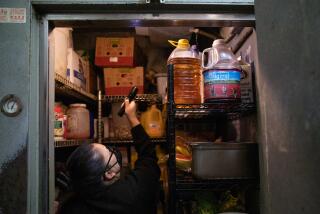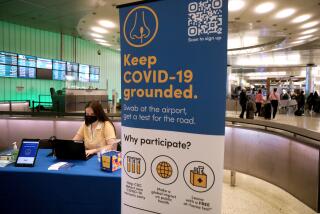Knowing the Score on Ship Sanitation
- Share via
When travelers book a cruise, they ask about cabin accommodations, rates, ports of call, dinner seatings and, perhaps, captain’s parties. But few inquire about the ship’s sanitation score, according to travel agents who book cruises. One possible reason may be that many travelers have never heard of them.
“About 25% of people ask,” said Bell Desouza, manager of Advantage Travel in Burbank, who often books cruises. The more upscale the clients and the more often they have taken a cruise, he said, the more likely they are to inquire.
While cruise ship sanitation scores--based on regular inspections--are not new, cruise ship inspections themselves have been part of the Vessel Sanitation Program since it was formally organized in 1975 by the federal Centers for Disease Control and Prevention. The Sanitation Program was instituted to lower the risk of gastrointestinal disease outbreaks, which can spread rapidly in the close quarters of a cruise ship, and to improve the overall healthfulness of the environment by making sure equipment such as the cooling and heating systems is working properly, according to a CDC spokesman.
Numerical scores of up to 100 have always been applied but until recently were not made public, said Tom O’Toole of the CDC’s Center for Environmental Health, which administers the Vessel Sanitation Program. O’Toole said the center “(began) publishing actual scores, rather than simply pass or fail, in 1989 in our Green Sheet,” a CDC publication widely distributed to media, travel agents and the general public.
Under the program, every vessel that carries 13 or more passengers and has a foreign itinerary is subject to two inspections per year and, when needed, reinspections. Ships that sail only from foreign ports are not inspected under the program, said Donald W. Turner, deputy chief of the program, nor are ships in the American Hawaii line because they do not sail to foreign ports. (American Hawaii is monitored by the Hawaii Department of Health and the Food & Drug Admininstration, through inspections similar to those of CDC.)
*
During the unscheduled visits by officials from the Vessel Sanitation Program, inspectors evaluate the water supply, food preparation methods and temperature at which food is stored. Also evaluated are employee practices and personal hygiene, and general cleanliness of the vessel. Inspectors look closely at other areas of the ship, such as the bars, to be sure ice is not contaminated, Turner said. Cabins are inspected both for cleanliness and for excess moisture, which can spread disease.
“We also look at fan rooms, checking the air intake,” Turner said. “Sometimes we recommend they change the filters.”
The cleaner the filters, the less likely bacterial disease will spread. “A dirty filter is more likely to have bacteria,” O’Toole said.
A score of 86 or higher is considered acceptable. Perfect scores of 100 are rare, said Turner. In his 5 1/2 years on the job, he recalls only three ships getting 100%.
About 60% of the score reflects food and equipment-related criteria, Turner said. The lower the score, the lower the sanitation level. But a low score does not automatically mean that the risk of gastrointestinal disease is imminent, according to CDC experts.
A variety of factors and conditions can pull a score down below 86. It is a judgment call on whether, and at what score, inspectors decide to recommend a ship not sail. There is no set score at which a cruise ship should not leave port, Turner said. Rather, it depends on the kind of problems found and how quickly they can be reversed. A malfunctioning refrigeration unit, for example, might be replaced with a new unit in a matter of hours; other broken equipment might have to wait for ordered parts to arrive.
Officials from the Vessel Sanitation Program can recommend that a ship not sail. They have done so about three or four times in the past five years, Turner said. Usually, this recommendation follows discovery of contaminated water supplies, inadequate water treatment or violations in food handling.
Most cruise lines readily comply with this recommendation, according to Turner and O’Toole and spokeswomen from two cruise lines.
“If a cruise ship does not follow CDC’s no-sail recommendation, we can ask the Coast Guard to enforce U.S. quarantine laws and detain the ship,” O’Toole said.
“Most (cruise lines) start to take corrective action even during the inspection,” Turner said. But a reinspection can be scheduled within 30 to 60 days or even as soon as a few weeks, should the cruise line request it.
*
Free copies of the most recent sanitation inspection report on individual vessels are available by writing to the Chief, Vessel Sanitation Program, National Center for Environmental Health, 1015 North American Way, Suite 107, Miami, Fla. 33132. No self-addressed, stamped envelope is necessary. Travelers can also request a free copy of “The Summary of Sanitation Inspections of International Cruise Ships” from the same office. Those sailing on American Hawaii ships can request free inspection scores from the Hawaii Department of Health, Sanitation Branch, 591 Ala Moana Blvd., Honolulu, Hawaii 96813.
Knowing the CDC sanitation rating of a cruise ship before sailing “is a good way to compare on a relative basis how ships are doing,” said Dr. Carter Hill, a Seattle emergency physician and chair of the Section of Cruise Ship and Maritime Medicine for The American College of Emergency Physicians. But he cautions that there is “day-to-day variability.” The score a ship received during last week’s inspection could change if it is inspected the next week.
Still, the industry is improving, said Carter, who also serves as medical director of Holland America and Windstar Cruise Lines. “Cruise ships are cleaner than most restaurants, in my opinion,” he said.
Even passengers sailing on a ship with a perfect sanitation score are at risk of certain ailments simply because of the closed spaces, Hill said. “It’s like being in a day-care center,” he said. “The quarters are closer than in some workplaces and homes.” If a few passengers have colds, the germs are likely to spread quickly.
Turner agreed that sanitation conditions on board cruise ships are improving, partly due to the training his program provides to crews. “We don’t just mark an inspection sheet,” he said. “We’ve done a lot of educating.”
The Healthy Traveler appears the second and fourth week of every month.
More to Read
Sign up for The Wild
We’ll help you find the best places to hike, bike and run, as well as the perfect silent spots for meditation and yoga.
You may occasionally receive promotional content from the Los Angeles Times.






